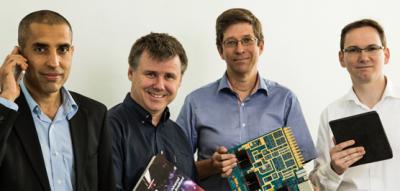Carles Puente, Carmen Borja, Jaume Anguera, Jordi Soler, Edouard Rozan
Fractal-based antennae for mobile phones
Finalists for the European Inventor Award 2014
In 1995, Carles Puente Baliarda and his team invented the world’s first fractal-based antenna for mobile communication. The antennae derive their name – and powerful broadcast abilities – from geometrical properties: Fractals are patterns consisting of multiple small copies of themselves, which allows for “coiling” long antennae into the small confines of mobile devices.
Conventional antennae, such as the ones used in FM broadcast, require a certain length in order to broadcast and receive signals at full capacity; about 1.5 metres for a standard radio antenna. The self-repeating patterns in fractals allow the length of the antennae to be arranged into a tight space. Additionally, multiple antennae can be intertwined to receive signals on different frequency ranges such as Wi-Fi, GPS or Bluetooth.
Societal benefit
Puente Baliarda’s invention opened the doors for the “Internet anywhere” revolution with highly compact and mobile devices. The impact of fractal-based antennae becomes apparent by comparing the size and capacity of a 20-year-old mobile phone with today’s devices. Early mobile phones needed antennae at least 15 cm long, but with fractal-based antennae, the size and performance of the phones are no longer confined by spatial constraints.
Economic benefit
Fractus, the company cofounded by Puente Baliarda to market his invention, reported a turnover of US $3.6 million in 2009. Meanwhile, the company has expanded its business model: Instead of only producing antennae, Fractus also licenses its technology to third parties. Strategic licensing agreements with large mobile phone manufacturers such as LG, HTC or Motorola contributed to the turnover rising to US $111 million in 2012. Today, Fractus is the global market leader for developing and producing fractal-based antennae, with more than 200 150 registered patents.
According to a report by BCC Research, the global market for antennae is expected to grow from US $13.4 billion in 2012 to $ 16.9 billion in 2017. In 2011, 9.7 billion fractal-based antenna units were supplied worldwide. To put this in context, Fractus supplied more than 35 million units worldwide, which is 0.4% of the global turnover. An estimated 19.6 billion will ship by 2017.
How it works
A fractal is a mathematical set or pattern that consists of so-called "self-similar" individual elements that each have the same shape as the full set: Imagine a tree shape made out of smaller trees. Based on fractal shapes, fractal-based antennae consist of several repeating elements, or "iterations", manufactured using the same processes and materials used to create printed circuit boards.
Each iteration of a fractal-based antenna also corresponds to a certain range of frequencies. The presence of multiple iterations means that fractal-based antennae can operate over multiple frequencies and bandwidths - something that cannot be found in the limited capacities of classical "linear" antennae.
The inventor
Born in Badalona in Catalonia (Spain), Puente Baliarda began brainstorming concepts for a novel antenna while studying engineering at the Polytechnic University in Barcelona in the 1990s. The challenge: Shrinking the size while increasing broadcast capabilities. Inspired to find a solution, he began working on the quirky invention – blending the apparently unrelated disciplines of electromagnetic theory and fractal geometry – with neither a commission to work nor any financial support.
Did you know?
One example from nature illustrating the concept of self-repeating patterns – like those used in fractal-based antennae – are ferns, which are made up of many leaves which in and of themselves look like small ferns.
Media gallery
Contact
European Inventor Award and Young Inventors Prize queries:
european-inventor@epo.org Subscribe to the European Inventor Award newsletterMedia-related queries:
Contact our Press team#InventorAward #YoungInventors














